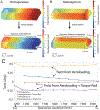Elastic Shape Morphing of Ultralight Structures by Programmable Assembly
- PMID: 33479558
- PMCID: PMC7816774
- DOI: 10.1088/1361-665X/ab0ea2
Elastic Shape Morphing of Ultralight Structures by Programmable Assembly
Abstract
Ultralight materials present an opportunity to dramatically increase the efficiency of load-bearing aerostructures. To date, however, these ultralight materials have generally been confined to the laboratory bench-top, due to dimensional constraints of the manufacturing processes. We show a programmable material system applied as a large-scale, ultralight, and conformable aeroelastic structure. The use of a modular, lattice-based, ultralight material results in stiffness typical of an elastomer (2.6 MPa) at a mass density typical of an aerogel (5.6 ). This, combined with a building block based manufacturing and configuration strategy, enables the rapid realization of new adaptive structures and mechanisms. The heterogeneous design with programmable anisotropy allows for enhanced elastic and global shape deformation in response to external loading, making it useful for tuned fluid-structure interaction. We demonstrate an example application experiment using two building block types for the primary structure of a 4.27m wingspan aircraft, where we spatially program elastic shape morphing to increase aerodynamic efficiency and improve roll control authority, demonstrated with full-scale wind tunnel testing.
Figures











References
-
- Jun JW, Silverio M, Llubia JA, Markopoulou A, Dubor A et al. 2017
-
- Senatore G, Duffour P and Winslow P 2018. Engineering Structures 167 608–628
-
- Joshi S, Tidwell Z, Crossley W and Ramakrishnan S 2004. Comparison of morphing wing stategies based upon aircraft performance impacts 45th AIAA/ASME/ASCE/AHS/ASC Structures, Structural Dynamics & Materials Conference p 1722
-
- Barbarino S, Bilgen O, Ajaj RM, Friswell MI and Inman DJ 2011. Journal of intelligent material systems and structures 22 823–877
-
- Weisshaar TA. Morphing aircraft technology-new shapes for aircraft design Tech. rep. PURDUE UNIV LAFAYETTE IN. 2006.
Grants and funding
LinkOut - more resources
Full Text Sources
Other Literature Sources
